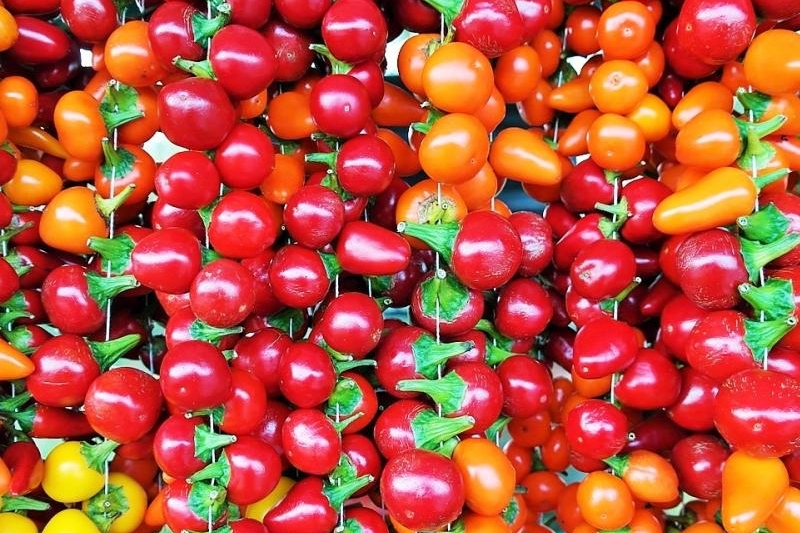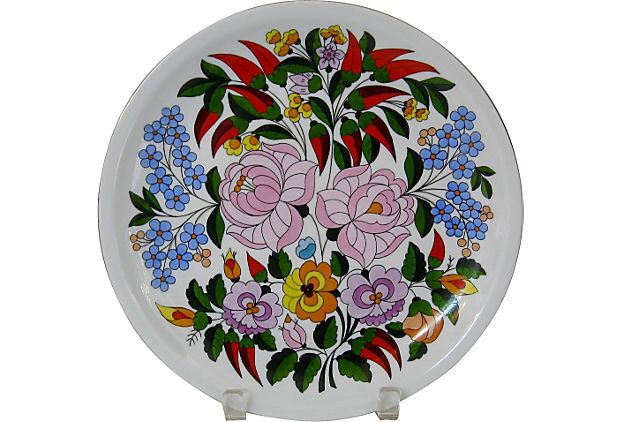
They come in a wide range of colors, flavors, shapes, heat levels and sizes. From small compact plants, to giant monsters that can get over 9 feet tall, with peppers ranging in size from a tiny fraction of an inch to over a foot long, and coming in nearly every color of the rainbow.
The Capsicums are ancient natives of the New World, the oldest known specimens coming from Mexico. From seeds found on the floors of caves that were ancient human dwellings and from ancient fossil feces, scientists have found the people were eating peppers as early as 7000 BC., among the oldest cultivated plants of the world.
Peppers are used in both whole and powdered forms. It is basically a spice made from grinding dried bell peppers and chili peppers. Paprika is not just a spice that adds color, but is also rich in vitamin C and carotenoids, providing a variety of health and beauty benefits. Paprika has a range of tastes from sweet to smoky to spicy to savory, all of which depends on how it was dried and prepared.
Paprika and health benefits
Paprika is very low in Cholesterol and Sodium. It is also a good source of Thiamin, Magnesium, Phosphorus, Copper and Manganese, and a very good source of Dietary Fiber, Vitamin A, Vitamin C, Vitamin E (Alpha Tocopherol), Vitamin K, Riboflavin, Niacin, Vitamin B6, Iron and Potassium. In Szent-Gyorgi’s Nobel Prize winning research on Vitamin C in 1937, he had been using a substance, obtained from adrenal glands, that he suspected to be Vitamin C. Paprika is packed beta-carotene also.
Capsaicin is one of the main compounds in the pepper family that provides health benefits - due to the lack of capsaicin in sweet paprika, health benefits arent as strong (as cayenne or chilli powder). If you cant stand the heat of cayenne pepper, then opt for Paprika - get the benefits without the heat. These benefitial effects are:
 |
Paprika and folk medicine Paprika’s medicinal benefits are focused mainly around the fact that it comes from the ‘Capsicum annuum’ pepper plant family. It is used in folk medicine in various parts of the world, notably Greece, Italy, and parts of Russia, where it is steeped in Vodka and drunk as a tonic in wine glassful doses. The most common medical use of Cayenne is as a gastric stimulant and digestive aid. It rebuilds the stomach tissue and stimulates peristalsis, thus assisting in assimilation and elimination. In the West Indies, a preparation called Mandram is used for weak digestion and loss of appetite. The American Indians used to say you could get rid of a wart if you bound on a fresh pepper pod every day. Last centuries paprika was used avoiding yellow fever too. You can read more interesting facts about history of cayenne. |
The medicinal Cayenne is classed according to its BTU rating rather than its species. Cayenne pepper is the name for the hottest form of Capsicum, which can take other forms. If its heat is 1 BTU, this mild Capsicum is called paprika; if it is from 1-25 BTU, it is called simply red pepper; but over 25 BTU rating is termed Cayenne. Therefore Cayenne is the strongest of the Capsicum family.
Paprika and dietary
Paprika is an awesome stimulant and energizer, which can be used to treat conditions like tiredness, lethargy, and depression. Inclusion of paprika in your diet can inhibit the growth of harmful bacteria. Paprika is a powerhouse of vitamin C. It contains 6-9 times as much vitamin C as tomatoes. If you’re having a hard time digesting certain foods, it may be a good idea to eat some paprika. Paprika helps to normalize your stomach acids, preventing them from eating into the lining of your stomach. It can also help to facilitate digestion and boost the production of both stomach acids and saliva. If you have indigestion, a bit of paprika can help to calm your stomach. Drink the tea if you have problems with flatulence.
Nutrition facts as 1 tablespoon of dried paprika powder has
 |
Paprika and presence
Pepper variety names are not all standardized and can sometimes seem a bit perplexing. Sometimes the same pepper may be called by different names, depending on where it is grown. There are four or five major species of cultivated Capsicum, and within those species are several "taxonomic varieties". The species and varieties include many economically important cultivars with different shapes, colours, and flavours that are grown for different purposes. |
Other important varieties are grown in Japan (predominantly used, dried, in cooking), the United States, and Africa, the latter being valued as a high-quality medicinal Cayenne. In England, Cayenne was called “Ginnie pepper,” since it was purchased from “Guinea,” or the Indies. Other names for Cayenne include African pepper, African red pepper, and African bird pepper, this can be light brownish-yellow instead of red in color. In Hungary, six different varieties of paprika are available with flavors ranging from delicate to hot.
Paprika and allergy
Paprika is generally designated as safe for general or specific, limited use in food and cosmetic products. However, high doses of paprika may interact with other medications, so it is advisable to consult your physician before using paprika for medical or beauty purpose.
 |
Paprika and foods Hot’ and ‘Spicy’ are the words to describe Paprika Powder which is made from grinding the fruits of bell pepper or chili pepper (Capsicum annuum). The flavor of the spice ranges from mild to hot, and varies from country to country. It is mostly used as a seasoning. There is many type of dried paprika powder such as Spanish smoked paprika, or pimentón. Unlike Hungarian-grown paprika, in which the peppers are slowly sun-dried, pimentón is slowly smoked over a fire, imparting an unbelievably rich and smokey flavor. It needs to be heated in a moist environment, preferably oil, to really release its flavor. Paprika is widely used in Hungarian cuisine, with the finest quality paprika coming from this country. |
Paprika is the national spice in Hungary and is enjoyed it a variety of dishes including goulash, chicken paprikash, cheese, eggs, fish and pasta salad. Read more about how to prepare Hungarian Fisherman soup with sweet paprika powder. California paprika is ground from a beautiful, deep red hybrid pepper grown in California. Where traditional Hungarian sweet paprika has a slightly bitter edge, this paprika has a faint lemony topnote. There is organic paprika is grown in Israel, which has grown paprika chilies since they were brought from Spain by the conquering Ottoman Turks. It has a darker color than most sweet paprikas, with an earthy, raisiny flavor reminiscent of ground ancho pepper. Use this organic paprika in any recipe calling for sweet paprika.
Paprika is also used in Austrian, Moroccan, and Indian cuisines. It is spice to flavor cheeses, cheese spreads, processed meats, tomato sauces, biscuits, baked products, chili powders and soups. It is used as a colorant. Any ready to eat or convenience food colored red, orange or reddish brown with the label claiming ‘Natural Color’, it is paprika. Paprika is also uses as an emulsifier, bonding with oil and vinegar to create a range of salad dressings. But as paprika burns quickly, dont let it spend more than a few seconds in hot oil before adding something water-based.
Paprika and cosmetics
Paprika is found in cosmetic products like lip gloss and hair care products like shampoos, treatments, conditioners and dyes. Paprika extract (Capsicum frutescens), also known as paprika oleoresin, is a red viscous liquid obtained from dried and ground red peppers by extraction and further concentration. Paprika Balsam enriched with red chili, ginger, nettle, menthol and essential oils to heat and energize the muscles, morover you may find massage oil with paprika extract too. You can prepare a facial mask by combining a tablespoon of sweet (not hot!) paprika with two tablespoons of honey. Apply it all over your face (except around eyes) in an even layer and leave for 20 minutes. This will help your skin tone as well as reduce fine lines, wrinkles, age spots, sagging skin, and dullness, making your skin soft and glowing sweet paprika powder can be added to henna to impart a reddish tint to hair while coloring it. However, before using it on your scalp, it is advisable to do a patch test on the inside of your wrist to avoid an allergic reaction.
 |
Paprika and decoration If you like sweet or hot chili paprika to use all over the year just make a beautiful paprika garland and dry it on room temperature or you can decorate your kitchen with paprika motife. Hungarian folk embroidery applied variation of paprika motifs in wall paintings, cloths and wall plates. |
 |
Paprika and festival Along with other festivals worldwide, Kalocsa Paprika Festival held in heart of Hungary. The most interesting program in connection with the paprika cultivation, processing and consuption is the ’paprika dishes competition’, which is an all day long activity. Among fair, folklore programmes and enjoyable musics you can taste paprika dishes, too. More information gotohungary.com. |
Become part of the CK community by uploading and sharing traditional or personal recipes. Once you've logged in you can upload, save and print your dishes online.